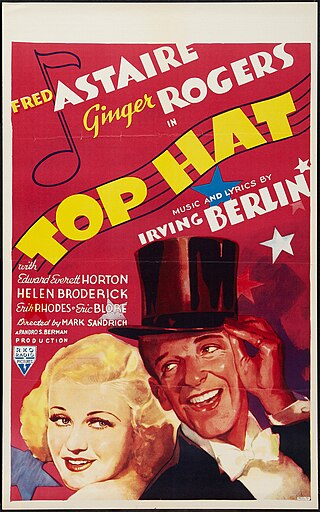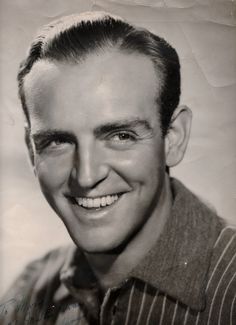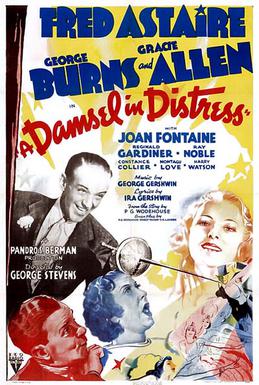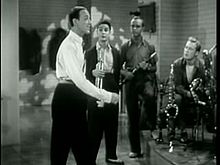
The Gay Divorcee is a 1934 American musical romantic comedy film directed by Mark Sandrich and starring Fred Astaire and Ginger Rogers. It also features Alice Brady, Edward Everett Horton, Erik Rhodes, and Eric Blore. The screenplay was written by George Marion Jr., Dorothy Yost, and Edward Kaufman. It is based on the Broadway musical Gay Divorce, written by Dwight Taylor, with Kenneth Webb and Samuel Hoffenstein adapting an unproduced play by J. Hartley Manners.

Top Hat is a 1935 American musical screwball comedy film in which Fred Astaire plays an American tap dancer named Jerry Travers, who comes to London to star in a show produced by Horace Hardwick. He meets and attempts to impress Dale Tremont to win her affection. The film also features Eric Blore as Hardwick's valet Bates, Erik Rhodes as Alberto Beddini, a fashion designer and rival for Dale's affections, and Helen Broderick as Hardwick's long-suffering wife Madge.

Ginger Rogers was an American actress, dancer and singer during the Golden Age of Hollywood. She won an Academy Award for Best Actress for her starring role in Kitty Foyle (1940), and performed during the 1930s in RKO's musical films with Fred Astaire. Her career continued on stage, radio and television throughout much of the 20th century.

Fred Astaire was an American dancer, actor, singer, musician, choreographer, and presenter, whose career in stage, film, and television spanned 76 years. He is widely regarded as the "greatest popular-music dancer of all time" He received an Honorary Academy Award, a BAFTA Award, three Emmy Awards, two Golden Globe Awards, and a Grammy Award.

Holiday Inn is a 1942 American musical film starring Bing Crosby and Fred Astaire, with Marjorie Reynolds, Virginia Dale, and Walter Abel. It was directed by Mark Sandrich with music by Irving Berlin. The composer wrote twelve songs specifically for the film, the best known being "White Christmas". The film features a complete reuse of the song "Easter Parade", written by Berlin for the 1933 Broadway revue As Thousands Cheer and used as a highlight of the 1948 film Easter Parade, starring Astaire and Judy Garland. The film's choreography was by Danny Dare.

Easter Parade is a 1948 American Technicolor musical film directed by Charles Walters, written by Sidney Sheldon, Frances Goodrich, and Albert Hackett from a story by Goodrich and Hackett, and starring Judy Garland, Fred Astaire, Peter Lawford, and Ann Miller. The film contains some of Astaire's and Garland's best-known songs, including "Easter Parade", "Steppin' Out with My Baby", and "We're a Couple of Swells", all by Irving Berlin.

Swing Time is a 1936 American musical comedy film, the sixth of ten starring Fred Astaire and Ginger Rogers. Directed by George Stevens for RKO, it features Helen Broderick, Victor Moore, Betty Furness, Eric Blore and Georges Metaxa, with music by Jerome Kern and lyrics by Dorothy Fields. Set mainly in New York City, the film follows a gambler and dancer, "Lucky" (Astaire), who is trying to raise money to secure his marriage when he meets a dance instructor, Penny (Rogers), and begins dancing with her; the two soon fall in love and are forced to reconcile their feelings.

Blue Skies is a 1946 American musical comedy film directed by Stuart Heisler and starring Bing Crosby, Fred Astaire, and Joan Caulfield. Based on a story by Irving Berlin, the film is about a dancer who loves a showgirl who loves a compulsive nightclub-opener who can't stay committed to anything in life for very long. Produced by Sol C. Siegel, Blue Skies was filmed in Technicolor and released by Paramount Pictures. The music, lyrics, and story were written by Irving Berlin, with most of the songs recycled from earlier works.
Herbert A. Magidson was an American popular lyricist. His work was used in over 23 films and four Broadway revues. He won the first Academy Award for Best Original Song in 1934.

John William Sublett, known by his stage name John W. Bubbles, was an American tap dancer, vaudevillian, movie actor, and television performer. He performed in the duo "Buck and Bubbles", who were the first black artists to appear on television in the US. He is known as the father of "rhythm tap."

Hermes Pan was an American dancer and choreographer, principally remembered as Fred Astaire's choreographic collaborator on the famous 1930s movie musicals starring Astaire and Ginger Rogers. He worked on nearly two dozen films and TV shows with Astaire. He won both an Oscar and an Emmy for his dance direction.

A Damsel in Distress is a 1937 American English-themed Hollywood musical comedy film starring Fred Astaire, George Burns, Gracie Allen and Joan Fontaine. Loosely based upon P.G. Wodehouse's 1919 novel of the same name and the 1928 stage play written by Wodehouse and Ian Hay, it has music and lyrics by George and Ira Gershwin. The film was directed by George Stevens, who had also directed Astaire in Swing Time (1936).

The Sky's The Limit is a 1943 romantic musical comedy film starring Fred Astaire and Joan Leslie, with music by Harold Arlen and lyrics by Johnny Mercer. The film was directed by Edward H. Griffith, and released by RKO Radio Pictures. Astaire plays a Flying Tiger pilot on leave. Robert T. Smith, a real former Flying Tiger pilot on leave before joining the Army Air Forces, was the technical adviser on the film. The comedy is provided by Robert Benchley — his second appearance in an Astaire picture — and Eric Blore, a stalwart from the early Astaire-Rogers pictures.

That's Entertainment, Part II is a 1976 American compilation film released by Metro-Goldwyn-Mayer and a sequel to That's Entertainment! (1974). Like the previous film, That's Entertainment, Part II was a retrospective of famous films released by MGM from the 1930s to the 1950s. Some posters for the film use Part 2 rather than Part II in the title.

The Belle of New York is a 1952 Metro-Goldwyn-Mayer Hollywood musical comedy film set in New York City circa 1900 and stars Fred Astaire, Vera-Ellen, Alice Pearce, Marjorie Main, Gale Robbins, and Keenan Wynn, with music by Harry Warren and lyrics by Johnny Mercer. The film was directed by Charles Walters.

Follow the Fleet is a 1936 American RKO musical comedy film with a nautical theme starring Fred Astaire and Ginger Rogers in their fifth collaboration as dance partners. It also features Randolph Scott, Harriet Hilliard, and Astrid Allwyn, with music and lyrics by Irving Berlin. Lucille Ball and Betty Grable also appear, in supporting roles. The film was directed by Mark Sandrich with script by Allan Scott and Dwight Taylor based on the 1922 play Shore Leave by Hubert Osborne.

Daddy Long Legs (1955) is a musical comedy film set in France, New York City, and the fictional college town of Walston, Massachusetts. The film was directed by Jean Negulesco, and stars Fred Astaire, Leslie Caron, Terry Moore, Fred Clark, and Thelma Ritter, with music and lyrics by Johnny Mercer. The screenplay was written by Phoebe Ephron and Henry Ephron, loosely based on the 1912 novel Daddy-Long-Legs by Jean Webster.

Three Little Words is a 1950 American musical film biography of the Tin Pan Alley songwriting partnership of Kalmar and Ruby. It stars Fred Astaire as lyricist Bert Kalmar and Red Skelton as composer Harry Ruby, along with Vera-Ellen and Arlene Dahl as their wives, with Debbie Reynolds in a small but notable role as singer Helen Kane and Gloria DeHaven as her own mother, Mrs. Carter DeHaven.

Shall We Dance is a 1937 American musical comedy film directed by Mark Sandrich. It is the seventh of the ten Fred Astaire-Ginger Rogers films. The story follows an American ballet dancer (Astaire) who falls in love with a tap dancer (Rogers); the tabloid press concocts a story of their marriage, after which life imitates art. George Gershwin wrote the symphonic underscore and Ira Gershwin the lyrics, for their second Hollywood musical.

Fred Astaire and Ginger Rogers were dance partners in a total of 10 films, nine of them released by RKO Radio Pictures from 1933 to 1939, and one, The Barkleys of Broadway, by Metro-Goldwyn-Mayer in 1949, their only film in Technicolor.






















